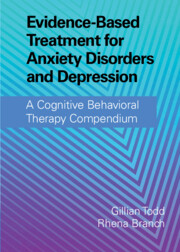 Evidence-Based Treatment for Anxiety Disorders and Depression
Evidence-Based Treatment for Anxiety Disorders and Depression Book contents
- Evidence-Based Treatment for Anxiety Disorders and Depression
- Evidence-Based Treatment for Anxiety Disorders and Depression
- Copyright page
- Contents
- Figures
- Tables
- Contributors
- 1 Introduction
- 2 The History and Philosophical Underpinnings of CBT:
- Part One Cognitive Behavioral Therapy for Anxiety Disorders
- 3 CBT for Specific Phobias
- 4 CBT for Panic Disorder
- 5 The Cognitive Behavioral Treatment of Agoraphobia
- 6 Cognitive Behavioral Therapy for Social Anxiety Disorder
- 7 CBT for Social Anxiety Disorder
- 8 CBT for Somatic Symptom Disorder and Illness Anxiety Disorder
- 9 Cognitive Behavioral Therapy for Generalized Anxiety Disorder:
- Part Two Cognitive Behavioral Therapy for Posttraumatic Stress Disorder
- Part Three Cognitive Behavioral Therapy for Obsessive-Compulsive Disorder and Associated Disorders
- Part Four Cognitive Behavioral Therapy for Depression
- Part Five Complexity and Comorbidity in Anxiety Disorders and Depression:
- Part Six Specialist Applications of Cognitive Behavioral Therapy for Anxiety Disorders and Depression
- Part Seven Future Developments
- Appendices
- Index
- References
6 - Cognitive Behavioral Therapy for Social Anxiety Disorder
from Part One - Cognitive Behavioral Therapy for Anxiety Disorders
Published online by Cambridge University Press: 06 January 2022
- Evidence-Based Treatment for Anxiety Disorders and Depression
- Evidence-Based Treatment for Anxiety Disorders and Depression
- Copyright page
- Contents
- Figures
- Tables
- Contributors
- 1 Introduction
- 2 The History and Philosophical Underpinnings of CBT:
- Part One Cognitive Behavioral Therapy for Anxiety Disorders
- 3 CBT for Specific Phobias
- 4 CBT for Panic Disorder
- 5 The Cognitive Behavioral Treatment of Agoraphobia
- 6 Cognitive Behavioral Therapy for Social Anxiety Disorder
- 7 CBT for Social Anxiety Disorder
- 8 CBT for Somatic Symptom Disorder and Illness Anxiety Disorder
- 9 Cognitive Behavioral Therapy for Generalized Anxiety Disorder:
- Part Two Cognitive Behavioral Therapy for Posttraumatic Stress Disorder
- Part Three Cognitive Behavioral Therapy for Obsessive-Compulsive Disorder and Associated Disorders
- Part Four Cognitive Behavioral Therapy for Depression
- Part Five Complexity and Comorbidity in Anxiety Disorders and Depression:
- Part Six Specialist Applications of Cognitive Behavioral Therapy for Anxiety Disorders and Depression
- Part Seven Future Developments
- Appendices
- Index
- References
Summary
This chapter begins with background on social anxiety disorder (SAD) and a review of a cognitive behavioral model of SAD. Next, we discuss the core components of cognitive behavioral therapy (CBT) for SAD and give an overview of literature. We then describe the diagnostic and assessment process, reviewing common clinician-administered and self-report measures. The latter portion of the chapter follows a case vignette of an individual with SAD seeking CBT. Using this illustration, we delineate the process of case formulation and conceptualization and present the use of a specific CBT protocol for SAD, reviewing each principal phase of treatment. This CBT protocol begins with psychoeducation and client socialization. It then advances to cognitive restructuring and behavioral exposure practice, and culminates with advanced cognitive work geared toward core beliefs. Treatment ends with a discussion of helpful ways to prevent relapse and preparing the client for termination.
Keywords
- Type
- Chapter
- Information
- Evidence-Based Treatment for Anxiety Disorders and DepressionA Cognitive Behavioral Therapy Compendium, pp. 93 - 114Publisher: Cambridge University PressPrint publication year: 2022


